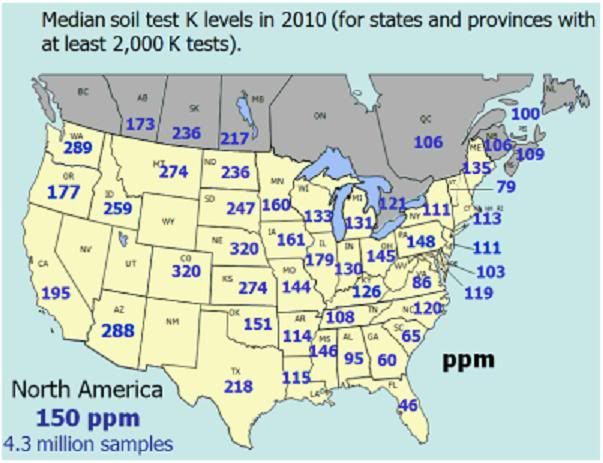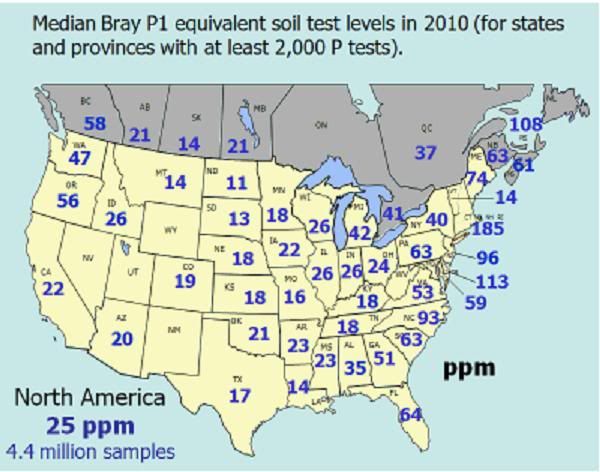The International Plant Nutrition Institute (IPNI) has completed a summary of results of tests performed on approximately 4.4 million soil samples collected in the fall of 2009 and spring of 2010 to compile maps and reports on the nutrient content of soils in the U.S. and Canada. It compiled soil sampling data to report on phosphorus, potassium, sulfur, magnesium, zinc, chloride, and pH. This 2010 summary is probably the most comprehensive evaluation of soil fertility ever conducted in North America. (phosphorus=P, potassium=K)
The study concludes:
The following excerpt helps to answer that question and it looks like my farm is a special place:
Plus, by comparing potassium data from earlier in the past decade, some interesting and confusing results were produced:
Next, is the report's summary on Phosphorus levels:
Most importantly, the study emphasizes the need to do nutrient management on a site-specific basis. Farmland buyers and investors should pay attention to these reports, too, as fertilizer prices are becoming increasingly expensive and the future potential to grow crops utilizing agroecological methods instead of supplementing with fertilizer will become more and more important.
_______________________
References, Maps, and to order reports of the study:
The Fertility of North American Soils
PDF version
Summary and References
2006 Potash and Phosphate Institute Report
The study concludes:
- 41% of the P tests and 39% of the K tests indicated that fertilizer should be applied each year to avoid profit loss by most major crops. Little management flexibility exists for these soils.
- For typical build-maintenance recommendation programs, 56% of the P tests and 52% of the K tests indicated a rate of at least crop removal would be needed.
The following excerpt helps to answer that question and it looks like my farm is a special place:
The distribution of the most fertile and least fertile soils for K is much different than for P. Annual K addition was generally most often needed in the Southeast and least often needed in the central Great Plains. Nebraska shows the lowest frequency of annual need at 7%, while Georgia shows the highest frequency of 77%. These regional differences are due primarily to indigenous soil properties. The central Great Plains and much of western North America generally have high K soils due to the prevailing climate and dominance of soils that have developed from high K parent materials. However, crop removal over several decades with limited nutrient addition is significantly reducing soil K levels in this region. On the other hand, the Southeast experiences a more intense weathering environment and has soils developed from parent materials lower in K and with a limited capacity to hold onto plant available K.
Plus, by comparing potassium data from earlier in the past decade, some interesting and confusing results were produced:
Nearly half the states and provinces (46%) west of the Mississippi River indicate decreases in soil K levels. This is not surprising since these states have many high K testing soils, reducing K fertilization. The result is gradual soil test depletion over time as high indigenous levels are depleted by crop removal. Growers in these states need to diligently monitor levels in their fields as more of them continue to drop into ranges where fertilization is needed. The other trend is the increasing K levels in the heart of the Corn Belt. This is a puzzling trend since K application in most of these states is less than crop removal. Research is planned and underway to understand more about the K dynamics in these important soils.
Map showing states with above and below median K levels:

Soil K - The median K level for NA for the 2010 crop was 150 ppm, a 4 ppm decline from 2005. Median K levels in many states east of the Mississippi River and in the provinces of eastern Canada are at or below agronomic critical levels, indicating that 50% or more of the sampled areas represented likely require annual K application to avoid yield losses. The higher K levels in the West reflect the less weathered status of western soils. However, along the western Corn Belt and much of the Great Plains, crop removal far in excess of K additions are consistent with the declines in soil tests observed from 2005 to 2010. Many areas in the Northeast also experienced significant K declines.

Soil K - The median K level for NA for the 2010 crop was 150 ppm, a 4 ppm decline from 2005. Median K levels in many states east of the Mississippi River and in the provinces of eastern Canada are at or below agronomic critical levels, indicating that 50% or more of the sampled areas represented likely require annual K application to avoid yield losses. The higher K levels in the West reflect the less weathered status of western soils. However, along the western Corn Belt and much of the Great Plains, crop removal far in excess of K additions are consistent with the declines in soil tests observed from 2005 to 2010. Many areas in the Northeast also experienced significant K declines.
Next, is the report's summary on Phosphorus levels:
For North America, 41% of the 3.4 million soil samples collected for the 2005 crop year indicated that P fertilizer should be applied each year to avoid profit loss by most major crops. States and provinces varied greatly from a low of 13% in Delaware to a high of 87% in North Dakota and Saskatchewan. Annual P addition tended to be most often needed in the Northern Great Plains and Midsouth and least often in the Mid-Atlantic and Northeast regions. If a typical build-maintenance soil fertility program is being followed, 56% of the samples indicated a P rate of at least crop removal is needed. Regional differences in P fertility are due to a combination of historical manure or fertilizer use patterns and differences in indigenous soil properties.
Map showing states with above and below median P levels:

Soil P - The 2010 summary indicates the median P level (50% of samples are above and below this level) for NA for the 2010 crop was 25 ppm, a 6 ppm decline from 2005. Phosphorus levels vary markedly among states and provinces with the northern Great Plains generally having the lowest P levels as has been the case in past summaries. However, unlike much of the rest of the intensively cropped regions of the country, this region tended to show increases in soil P or at least no declines from the 2005 summary.

Soil P - The 2010 summary indicates the median P level (50% of samples are above and below this level) for NA for the 2010 crop was 25 ppm, a 6 ppm decline from 2005. Phosphorus levels vary markedly among states and provinces with the northern Great Plains generally having the lowest P levels as has been the case in past summaries. However, unlike much of the rest of the intensively cropped regions of the country, this region tended to show increases in soil P or at least no declines from the 2005 summary.
Most importantly, the study emphasizes the need to do nutrient management on a site-specific basis. Farmland buyers and investors should pay attention to these reports, too, as fertilizer prices are becoming increasingly expensive and the future potential to grow crops utilizing agroecological methods instead of supplementing with fertilizer will become more and more important.
References, Maps, and to order reports of the study:
The Fertility of North American Soils
PDF version
Summary and References
2006 Potash and Phosphate Institute Report